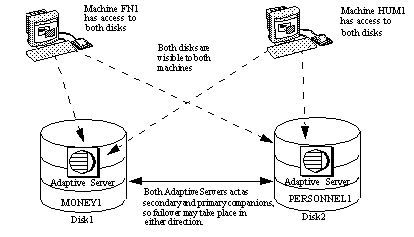Like asymmetric configuration, symmetric configuration consists of two fully functional Adaptive Servers running on separate machines, each with their own system devices, system databases, user databases, and user logins. However, when failover occurs, either of the Adaptive Servers acts as a primary or secondary companion for the other Adaptive Server.
Before you configure two Adaptive Servers as symmetric companions, you must first configure them as asymmetric companions.
Figure 3-2 describes a symmetric configuration between a financial department machine (FN1 running Adaptive Server MONEY1) and a human resources machine (HUM1 running Adaptive Server PERSONNEL1):
Figure 3-2: Symmetric configuration in a high availability system

During scheduled maintenance or system failure, either MONEY1 fails over to PERSONNEL1, or PERSONNEL1 fails over to MONEY1. Disk1 and Disk2 are both shared disks.
See the appropriate platform-specific configuration chapter for detailed information about configuring Adaptive Server in a symmetric setup.